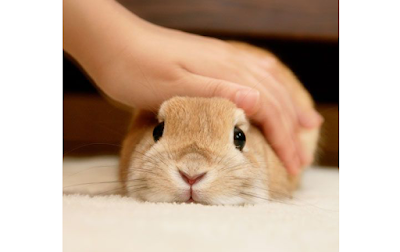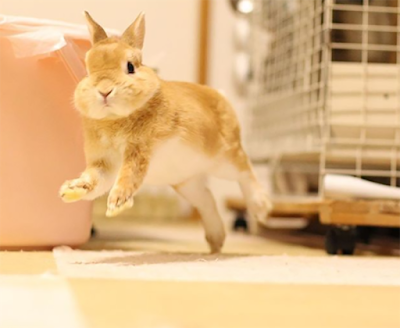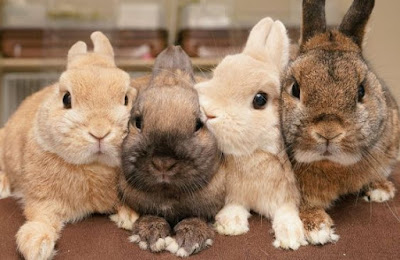What Is My Rabbit Thinking?: Understanding Your Rabbit's Behaviour
Among all types of domestic pets, we've got to inevitably admit that small animals are the toughest to read, especially for a novice. Explaining why understanding Rabbit's behaviour requires a little more time and effort can be stemmed from this theory— In the wild, Rabbits are preyed on by predatory animals. To be wary and alert of their surroundings is crucial for survival. Some of these instincts can still be observed in the domesticated Bun companions today.
 |
| Source |
Though Rabbits are slightly less vocal than as compared to Dogs or Cats, a comfortable Bun can be caught expressing their joy and/or unhappiness in many actions, even sounds. To better understand these behaviours, the following post is split into 2 segments:
Happiness and Content
Anger and Displeasure
Happiness And Content
1. Binky — Number one on the list has got to be the Binky. This movement involves a series of quick dance moves— hops + twists + mid-air jumps. An intricate dance so intense, sighting it for the first time might just leave you in awe, admiring your Bun's happiness.
2. Flop — We've all done this at one point or another. Coming home from a hard day’s work and flopping onto the couch just to rest. Only for this instance, Rabbits flop to their sides exposing their underbellies as a sign of content.
 |
| Source |
2. Flop — We've all done this at one point or another. Coming home from a hard day’s work and flopping onto the couch just to rest. Only for this instance, Rabbits flop to their sides exposing their underbellies as a sign of content.
 |
| Source |
3. Zen Mode — An incredibly calm and relaxed Rabbit isn’t tough to spot. Two main actions can be observed here. Sitting down
with legs tucked under their bodies (similar to a Cat or Dog)— A hovering-furball. The second will be evident from the way they lay flat on their bellies, legs sprawled out like a sun-basking Bun.
4. Rabbit Purr — Can Rabbits purr? Apparently so! Keep your ears peeled for this sound fondly referred to as a Rabbit's purr. Emitted by Bunnies clicking their teeth together— You just know some-bunny is enjoying all the attention, including your pats and strokes.
Listen in close for this!
5. Grooming — Being as fastidious as Rabbits are, grooming one another is a universal sign for displaying acceptance. If you have experienced some nipping or licking while holding your Rabbit pal, congratulations are in order— you are hereby accepted as a family member or close confidante, according to your Bun.
6. Mark Of Love — The scent gland of a Rabbit can be located underneath their chins, and acceptance can be observed in this other behaviour— Resting or rubbing of their chins on top of another Bun's head, or even your hand. Now you've been marked with love.
 |
| Source |
7. Nudges — A rather subjective behaviour but nonetheless not to be ignored. This can be a rather subjective behaviour, either your Bunny is yearning for some human attention, or you're in their way of something. Dole out those pats and strokes, or simply move ☺
Anger & Displeasure
1. Thump! — Frustration often leads to one having the urge to kick objects, even more so for our dear Rabbit companions, just how much strength do those hind legs behold? It is almost impossible to miss this auditory display— loud and strong enough to act as a warning to surrounding Buns of eminent danger lurking nearby.
2. Munchers — Powerful hind legs and speed aren’t the only defense mechanisms of a Rabbit. A nip or nibble is nothing compared to a full on bite when they are upset. The daily munching of those ever-growing teeth packs a strong set of jaws and teeth. Give an angry
Bun some space, to muster up some courage to feel safe and secure again.
3. Screaming — When a
Rabbit is terrified or in extreme pain, there is a high chance you’ll hear them
scream. We hope no Bunny parent ever has to hear this cry from their Rabbits, for this auditory behaviour can only mean one thing— your Bun is in agony and excruciating pain.
4. Grunting — A milder form of noise Rabbits might make when they are displeased can be described as a
low growl/grunt, sometimes be accompanied by short lunges. This could
happen while you are shifting their things, or cleaning their space when they
are around. To try calming them down, place your hand gently on their
heads and proceed to stroke. Otherwise, provide a safe and separate space for them to roam about whenever you are cleaning their area!
You might also be interested in:
Why Rabbits Do Not Make Great Starter Pets: Are You Suitable For A Rabbit?
Your Stories Can Be Heard Too
Do you own a Bun? Share your story with the rest of the world! Your voices are important to us and the Pets community! Our readers are encouraged to share their Pet-related reviews of a place and its services, experiences, even lifestyle tips and tricks to better our Pets lives, on our platform, one paw at a time. Be a part of an educational and informative Pets community because at ThePetsDialogue, your voices could make a huge difference on a global scale.
Write to us at [email protected] today!
Do you own a Bun? Share your story with the rest of the world! Your voices are important to us and the Pets community! Our readers are encouraged to share their Pet-related reviews of a place and its services, experiences, even lifestyle tips and tricks to better our Pets lives, on our platform, one paw at a time. Be a part of an educational and informative Pets community because at ThePetsDialogue, your voices could make a huge difference on a global scale.
Write to us at [email protected] today!
Write to us at [email protected] today!
Our website is a work in progress, however, if you did find our articles interesting please do feel free to share! For more Pet care tips and other Pet-related articles, head to www.thepetsdialogue.com ☺
Our website is a work in progress, however, if you did find our articles interesting please do feel free to share! For more Pet care tips and other Pet-related articles, head to www.thepetsdialogue.com ☺
Disclaimer
This article was written with informational purposes, as you know, we’d love to share our collective research and experiences as fellow Pet owners and lovers. It is not meant to alternate in any way as advice or diagnosis of Professionals.
ThePetsDialogue claims no credit for images posted on this article unless otherwise displayed/stated. All rights go to respective owners as mentioned. If you do not wish for your image(s) to appear here do drop us an e-mail and it will be removed promptly. If you do wish to use any of our original published information, you are welcome to contact us!
This article was written with informational purposes, as you know, we’d love to share our collective research and experiences as fellow Pet owners and lovers. It is not meant to alternate in any way as advice or diagnosis of Professionals.




Among all types of domestic pets, we've got to inevitably admit that small animals are the toughest to read, especially for a novice.
ReplyDeleteExplaining why understanding Rabbit's behaviour requires a little more time and effort can be stemmed from this theory— In the wild, Rabbits are preyed on by predatory animals.
To be wary and alert of their surroundings is crucial for survival.
Some of these instincts can still be observed in the domesticated Bun companions today.
Reliable Permit Solutions, LLC